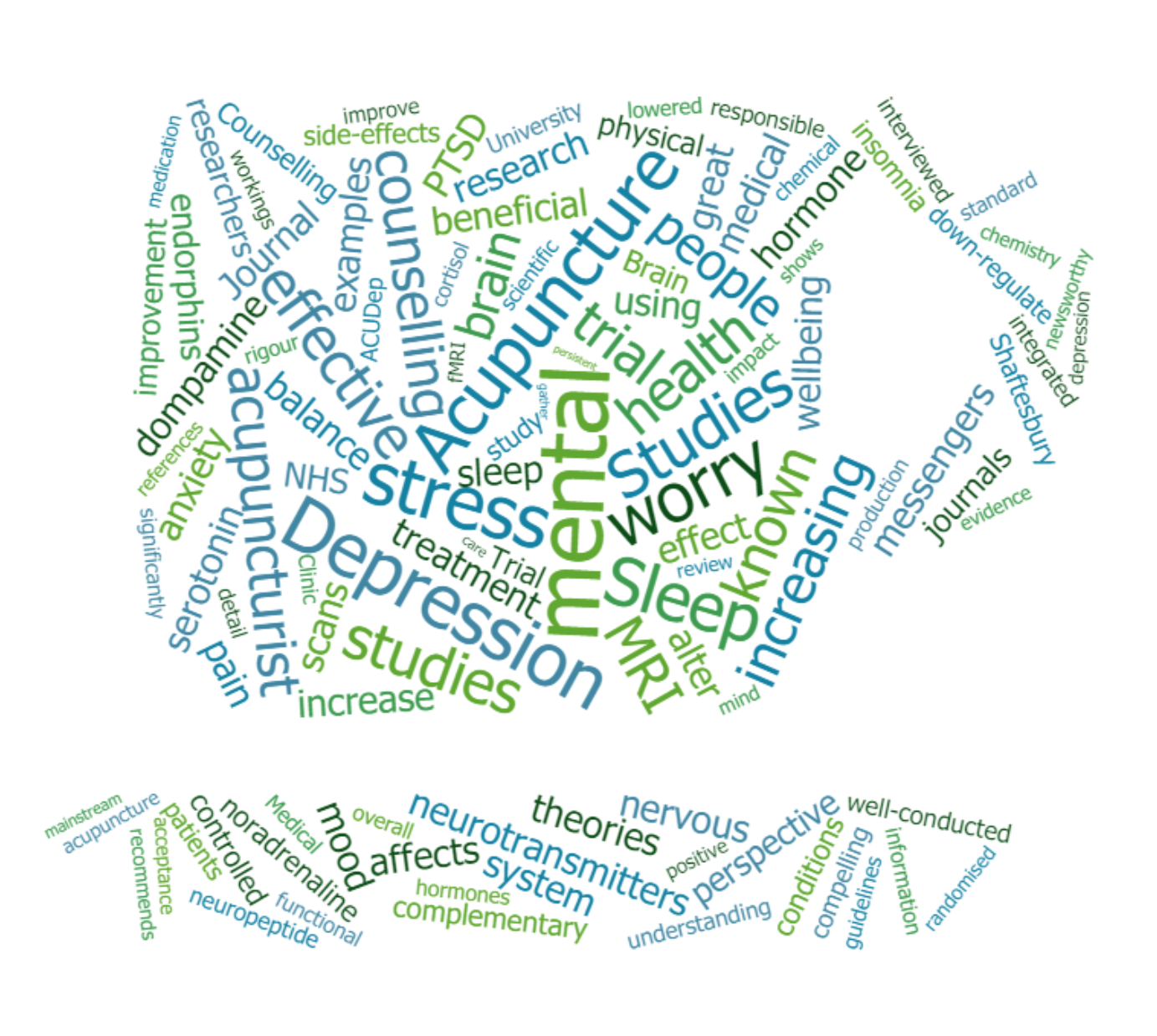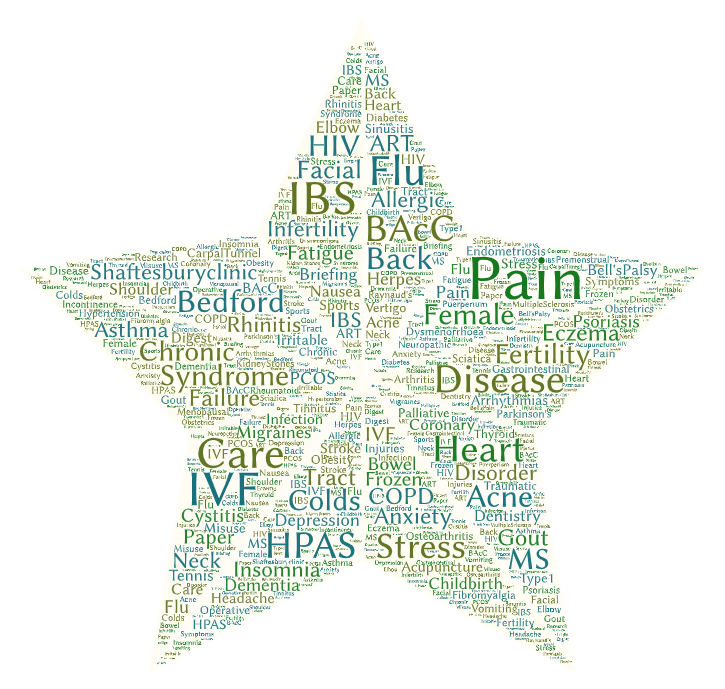Important to know: Chronic health conditions should be addressed under direct medical supervision of your GP or consultant, and acupuncture would be an adjunct or complement to usual care – we advise that you let you doctor know when you use this approach.
Sciatica
Sciatica is also known by its medical name lumbar radiculopathy, and is where nerves become impinged in the lower back, causing referred pain and neurological (nerve-related) symptoms into the areas that nerve supplies, usually buttock and lower limb.
Evidence suggests acupuncture may provide pain relief in sciatica; RCTs such as Wang (2009; n=139) comparing acupuncture and TENS and finding in favour of acupuncture; another finding for acupuncture’s effectiveness along with an increase in pain threshold in the true acupuncture group (Chen et al, 2009; n=90).
Other studies have looked at how the above may come about, for example Inoue et al (2008), in a clinical trial where patients had improvement in pain and nerve symptoms from lower back impingement, and put forward the theory that as seen in animal studies the blood flow in the region of the sciatic nerve was modulated by acupuncture, as well as the well known mechanisms of action of acupuncture in pain relief and inflammation reduction.
A network meta-analysis comparing 21 different therapies for sciatica (Lewis et al, 2015), finding acupuncture the second-best therapy in terms of addressing pain intensity and in terms of overall effect and having a statistically significant effect, leading them to suggest it should be considered as a treatment option.
Back pain
There is a strong correlation between back pain and sciatica, for which reason the following may be of interest.
Many parts of the NHS either offer or recommend acupuncture for back pain, with over 100 clinical practice guidelines worldwide giving positive recommendations for acupuncture for back pain (Birch et al, 2018). The Scottish Intercollegiate Guidelines Network recommends acupuncture for back pain.
Back pain was included in large chronic pain review of RCTs updating a previous meta-analysis (Vickers et al, 2018; 39 trials, n=20827) acupuncture showed a significant clinical superiority over usual care and a smaller advantage over sham. The researchers found that treatment effects persisted over time and couldn’t be explained solely in terms of placebo effects, meaning that acupuncture treatment was a reasonable option for some types of chronic pain, including back pain.
The American College of Physicians’ clinical practise guidelines nonpharmacologic treatment options for low back pain reviewed new evidence and found acupuncture useful for pain relief and to some extent function, although they had reservations about the strength of the evidence, meaning long term studies are needed (Chou et al, 2016, 2017).
The Clinical Practise Guidelines for managing low back pain, a systematic review on 13 sets of guidelines by the Ontario Protocol for Traffic Injury Management (OPTIMa) Collaboration looked at non-invasive techniques including acupuncture – acupuncture was one of the top recommended (non-invasive) interventions in the guidelines, where 10 sessions over 12 weeks was the recommended intervention for low back pain, and commented that high-quality guidelines support this whilst underlining that different techniques have different levels of effectiveness (Wong et al, 2017).
Another recent overview (Yin et al, 2017) confirms that there is increasing evidence for acupuncture as an effective, safe, and cost-effective intervention in chronic low back pain.
Mechanisms of Action
Acupuncture stimulates the body to create its own natural painkilling substances, such as Beta Endorphins (β-Endorphin). In studies acupuncture has been shown to stimulate the production of natural painkillers called opioid-like peptides (OLPs), including β-Endorphin: For example, this was shown in an RCT in 90 patients with a range of painful disorders (Petti et al, 1998). The same study showed acupuncture also and enhanced the activity of immune cells (lymphocytes, natural killer cells and monocytes) that help fight infections and diseases (Petti et al, 1998).
Acupuncture can activate mast cells at acupoints, which release histamine, serotonin, adenosine, and other mediators that modulate nerve transmission and inflammation (Li et al, 2022)
About the research: It is worth noting that in research, randomised controlled studies (RCT) are the most reliable in terms of quality of evidence, with a systematic review or meta analysis of numerous studies being the best way of seeing the overall picture of the state of the evidence. Below we have a selection of the available research, which does include some larger RCTs, and reviews of the literature alongside smaller studies. The n= figure tells you how many people were participants in the study.
Resources:
British Acupuncture Council evidence based factsheet about Sciatica including specific research, trials and mechanisms of action for acupuncture in this condition.
References:
Sciatica References:
Chen, M.R., Ping, W., Cheng, G., Xiang, G.U.O., Wei, G.W. and Cheng, X.H., 2009. The warming acupuncture for treatment of sciatica in 30 cases. Journal of Traditional Chinese Medicine, 29(1), pp.50-53.
Inoue, M., Kitakoji, H., Yano, T., Ishizaki, N., Itoi, M. and Katsumi, Y., 2008. Acupuncture treatment for low back pain and lower limb symptoms—the relation between acupuncture or electroacupuncture stimulation and sciatic nerve blood flow. Evidence-Based Complementary and Alternative Medicine, 5(2), pp.133-143.
Lewis, R.A., Williams, N.H., Sutton, A.J., Burton, K., Din, N.U., Matar, H.E., Hendry, M., Phillips, C.J., Nafees, S., Fitzsimmons, D. and Rickard, I., 2015. Comparative clinical effectiveness of management strategies for sciatica: systematic review and network meta-analyses. The Spine Journal, 15(6), pp.1461-1477.
Li, Y., Yu, Y., Liu, Y. and Yao, W., 2022. Mast cells and acupuncture analgesia. Cells, 11(5), p.860.
Wang ZX. [Clinical observation on electroacupuncture at acupoints for treatment of senile radical sciatica]. Zhongguo Zhenjiu 2009; 29(2): 126-8.
Back Pain References:
Vickers, A.J., Vertosick, E.A., Lewith, G., MacPherson, H., Foster, N.E., Sherman, K.J., Irnich, D., Witt, C.M., Linde, K. and Acupuncture Trialists’ Collaboration, 2018. Acupuncture for chronic pain: update of an individual patient data meta-analysis. The Journal of Pain, 19(5), pp.455-474.
Birch, S., Lee, M.S., Alraek, T. and Kim, T.H., 2018. Overview of treatment guidelines and clinical practical guidelines that recommend the use of acupuncture: a bibliometric analysis. The Journal of Alternative and Complementary Medicine, 24(8), pp.752-769.
Chou, R., Deyo, R., Friedly, J., Skelly, A., Hashimoto, R., Weimer, M., Fu, R., Dana, T., Kraegel, P., Griffin, J. and Grusing, S., 2017. Nonpharmacologic therapies for low back pain: a systematic review for an American College of Physicians Clinical Practice Guideline. Annals of internal medicine, 166(7), pp.493-505.
Chou, R., Deyo, R., Friedly, J., Skelly, A., Hashimoto, R., Weimer, M., Fu, R., Dana, T., Kraegel, P., Griffin, J. and Grusing, S., 2016. Noninvasive treatments for low back pain.
Wong, J.J., Côté, P., Sutton, D.A., Randhawa, K., Yu, H., Varatharajan, S., Goldgrub, R., Nordin, M., Gross, D.P., Shearer, H.M. and Carroll, L.J., 2017. Clinical practice guidelines for the noninvasive management of low back pain: A systematic review by the Ontario Protocol for Traffic Injury Management (OPTIMa) Collaboration. European journal of pain, 21(2), pp.201-216.
Lewis, R.A., Williams, N.H., Sutton, A.J., Burton, K., Din, N.U., Matar, H.E., Hendry, M., Phillips, C.J., Nafees, S., Fitzsimmons, D. and Rickard, I., 2015. Comparative clinical effectiveness of management strategies for sciatica: systematic review and network meta-analyses. The Spine Journal, 15(6),
Petti, F.., Bangrazi, A., Liguori, A., Reale, G. and Ippoliti, F., 1998. Effects of acupuncture on immune response related to opioid-like peptides. Journal of Traditional Chinese Medicine 18(1), pp.55-63.
Yin, C., Buchheit, T.E. and Park, J.J., 2017. Acupuncture for chronic pain: an update and critical overview. Current opinion in anaesthesiology, 30(5), pp.583-592.pp.1461-1477.


